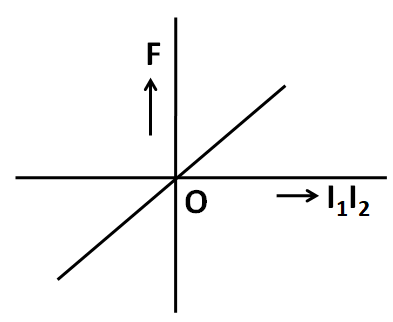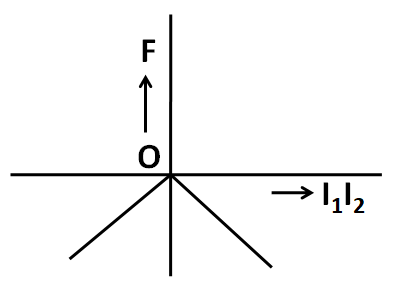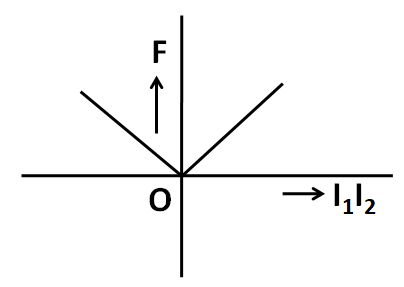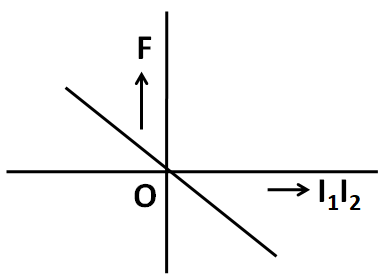
Answer
90.3k+ views
Hint: To solve this question, we need to determine the nature of the force for the parallel and the anti parallel currents. Then using the plot given in the question, we can get the correct plot out of the given options.
Formula used: The formula used to solve this question is given by
\[F = \dfrac{{{\mu _0}{I_1}{I_2}}}{{2\pi d}}\], here $F$ is the force between two wires carrying currents ${I_1}$ and ${I_2}$, and $d$ is the separation between the wires.
Complete step-by-step solution:
We know that the force between two current carrying wires is given by the formula
\[F = \dfrac{{{\mu _0}{I_1}{I_2}}}{{2\pi d}}\]
Now, the nature of this force (attractive or repulsive) is decided by the relative signs of the currents ${I_1}$ and ${I_2}$. We know that if the two currents are parallel, then the force is attractive in nature, but if the currents are anti parallel, then the force is repulsive in nature.
The parallel currents mean that the product ${I_1}{I_2}$ is positive. Also, the anti parallel currents mean the product ${I_1}{I_2}$ is negative.
In the graph given in the options B and C, the sign of the force is not changing with the sign of the product ${I_1}{I_2}$.
So both the options B and C are incorrect.
Now, according to the question, the attractive force is taken as negative, while the repulsive force is taken as positive. As stated above, when the product ${I_1}{I_2}$ is positive, then the force is attractive. But when the product ${I_1}{I_2}$ is negative, then the force is repulsive. So the sign of the force is opposite to the sign of the product ${I_1}{I_2}$.
Hence, the correct answer is option D.
Note: We need to carefully read the sign convention for the force given in the question. By looking at the formula for the force between two current carrying wires, we may conclude that the sign of the force is the same as that of the product ${I_1}{I_2}$. But the sign convention given in the question is just opposite to this.
Formula used: The formula used to solve this question is given by
\[F = \dfrac{{{\mu _0}{I_1}{I_2}}}{{2\pi d}}\], here $F$ is the force between two wires carrying currents ${I_1}$ and ${I_2}$, and $d$ is the separation between the wires.
Complete step-by-step solution:
We know that the force between two current carrying wires is given by the formula
\[F = \dfrac{{{\mu _0}{I_1}{I_2}}}{{2\pi d}}\]
Now, the nature of this force (attractive or repulsive) is decided by the relative signs of the currents ${I_1}$ and ${I_2}$. We know that if the two currents are parallel, then the force is attractive in nature, but if the currents are anti parallel, then the force is repulsive in nature.
The parallel currents mean that the product ${I_1}{I_2}$ is positive. Also, the anti parallel currents mean the product ${I_1}{I_2}$ is negative.
In the graph given in the options B and C, the sign of the force is not changing with the sign of the product ${I_1}{I_2}$.
So both the options B and C are incorrect.
Now, according to the question, the attractive force is taken as negative, while the repulsive force is taken as positive. As stated above, when the product ${I_1}{I_2}$ is positive, then the force is attractive. But when the product ${I_1}{I_2}$ is negative, then the force is repulsive. So the sign of the force is opposite to the sign of the product ${I_1}{I_2}$.
Hence, the correct answer is option D.
Note: We need to carefully read the sign convention for the force given in the question. By looking at the formula for the force between two current carrying wires, we may conclude that the sign of the force is the same as that of the product ${I_1}{I_2}$. But the sign convention given in the question is just opposite to this.
Recently Updated Pages
Name the scale on which the destructive energy of an class 11 physics JEE_Main

Write an article on the need and importance of sports class 10 english JEE_Main

Choose the exact meaning of the given idiomphrase The class 9 english JEE_Main

Choose the one which best expresses the meaning of class 9 english JEE_Main

What does a hydrometer consist of A A cylindrical stem class 9 physics JEE_Main

A motorcyclist of mass m is to negotiate a curve of class 9 physics JEE_Main







